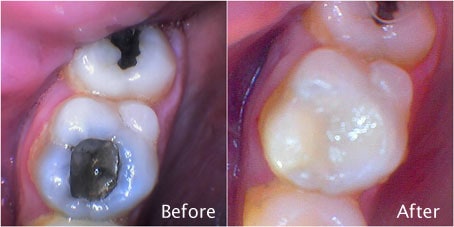
What is a Dental Filling?
A dental filling is a dental restoration fabricated to restore the function, anatomy and integrity of teeth that have been damaged by trauma or dental caries, also known as dental cavities or dental decay.
There are 2 types of restorations: Direct and Indirect.
Direct restorations
Are dental fillings made by placing dental filling material directly into your tooth the same day. Dental filling materials used for direct restorations include:
- Amalgam, also known as Dental Amalgam or Silver Filling
- Resin, also known as Composite, Composite Resin, Tooth Colored Filling or White Filling
Indirect restorations
Are dental fillings made outside of your mouth, usually in a dental laboratory, and cemented into your tooth.
- Ceramic, also known as Porcelain
- Gold Alloy
- Base Metal Alloy
Why are dental fillings necessary?
Tooth fractures and tooth decay expose the interior of the tooth to bacteria that normally have no access to the inside of your teeth. Once inside the teeth, sugars, starches and bacteria dissolve healthy tooth structure and cause infection of the tissues within the teeth.
Restoring damaged tooth structure with dental filling material has a number of benefits including:
* Limits damage caused by trauma and dental cavities, dental caries or dental decay.
* Protects the remaining tooth structure from further damage.
* Reestablishes adequate function of the tooth.
* Helps prevent damage to the nerve of the tooth.
* Helps prevent tooth loss.
* Makes it easier to clean your teeth.
* Lowers the bacterial count in your mouth.
* Helps you achieve and maintain fresh breath.
When is the best time to obtain Dental Filling?
The best time to have dental fillings placed is as soon as tooth damage or tooth decay is discovered. Dental caries, also known as dental cavities, advance over time. The presence of sugars and starches in the foods we eat combined with our normal oral bacteria create acids and promote the decay of tooth structure.
The earlier diseased tooth structure is removed and replaced by dental filling material the better because:
* A greater amount of healthy tooth structure is retained.
* The teeth are stronger because there is a greater ratio of strong tooth structure to dental filling material.
* Treatment is less complex and therefore of shorter duration.
* Treatment in early stages is often less expensive.
* Treatment is usually accomplished with more comfort with less post-operative sensitivity.
One of the primary benefits of regular, periodic oral examinations is early discovery of tooth damage and decay to enable timely restoration of teeth.
